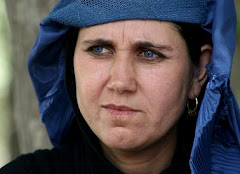KABUL, Afghanistan — American troops raked a large passenger bus with gunfire near Kandahar on Monday morning, killing and wounding civilians, and igniting angry anti-American demonstrations in a city where winning over Afghan support is pivotal to the war effort.
The shooting, which killed as many as five civilians and wounded 18, occurred on the eve of the most important offensive of the war. In coming weeks thousands of American, NATO and Afghan troops are expected to try to take control of the Kandahar region, the spiritual home of the Taliban.
It was the latest case in which NATO or American forces fired on and killed civilians near a checkpoint or military convoy because they were perceived to have come too close or to be approaching too fast.
Gen. Stanley A. McChrystal, the American and NATO commander in Afghanistan, has made reducing civilian casualties a priority, and they have gone down over the last year. But checkpoint and convoy shootings have not declined, worrying commanders who believe that such killings are turning Afghans against foreign forces.
Monday’s shooting demonstrated those concerns. Afterward, hundreds of demonstrators poured into the area around a bus station where the damaged bus was taken on the western outskirts of Kandahar.
They blocked the road with burning tires for an hour and shouted, “Death to America!” and “Death to infidels!” while condemning the Afghan president, Hamid Karzai, according to people there.
The American-led military command in Kabul called the killings a “tragic loss of life” and said that troops fired in the early morning light not knowing that the vehicle was a passenger bus and believing that it posed a threat to a military convoy clearing bombs from a highway.
But there were disputes over details including the number of dead, the relative positions of the convoys, and how the troops could not have understood that the vehicle was a passenger bus.
It was also unclear whether the troops had first shot flares and warned the driver to stay back, as military rules typically require. NATO said they did.
The governor of Kandahar Province, Tooryalai Wesa, called for the commander of the military convoy that opened fire to be prosecuted under military law.
“If you want to stop the bus, it should be shot in the tires,” Mr. Wesa said. “Why shoot the people inside?”
Mr. Karzai, whose relationship with the United States has been particularly fraught in recent weeks, called the shooting “unjustifiable” and said that “firing on a passenger bus is against the NATO commitment to save civilian lives.”
More than 30 people have been killed and 80 wounded in convoy and checkpoint shootings since last summer, but not one of the people killed was found to have been a threat, military officials say.
The shooting near Kandahar occurred just after daybreak, as the bus was taking scores of passengers to Nimruz Province, said Zalmy Ayoubi, a spokesman for Governor Wesa.
Two people who had been on the bus said that an American convoy 60 to 70 yards ahead opened fire as the bus began to pull to the side of the road to allow another military convoy to pass from behind.
“An American convoy was ahead of us and another convoy was following us, and we were going to pull off of the road, and suddenly the Americans opened fire,” said one, Nida Muhammad, a passenger who suffered a shoulder wound.
“We were not close to them, maybe 60 yards away from their convoy,” Mr. Muhammad said. A helicopter came for some wounded, he said.
“This bus wasn’t like a suicide bomber, and we did not touch or come close to the convoy,” he said. “It seems they are opening fire on civilians intentionally.”
The two convoys and the bus were on the main highway in the Zhari district, west of the city of Kandahar. The windows on one side of the bus were shot out.
Governor Wesa and his spokesman said five civilians were killed and 18 wounded. The governor blamed American forces and said a dozen of the wounded were in serious condition.
A statement issued by the American-led military command in Kabul said that four people were killed. It said “an unknown, large vehicle” drove “at a high rate of speed” toward a slow-moving NATO convoy that was clearing mines.
The convoy could not move aside because of a steep embankment. Troops used a flashlight and three flares to try to warn the driver.
“Perceiving a threat when the vehicle approached once more at an increased rate of speed, the patrol attempted to warn off the vehicle with hand signals prior to firing upon it,” the statement said. “Once engaged, the vehicle then stopped.”
“Upon inspection,” it said, NATO forces “discovered the vehicle to be a passenger bus.”
A military spokeswoman confirmed that a convoy traveling west, in front of the bus, opened fire, but said the second convoy was traveling east toward the passenger bus. She also said the driver of the bus was killed.
A survivor, however, identified himself as the driver and said he did not violate any signal from the troops. “I was going to take the bus off the road,” said the man, Mohammed Nabi. Then the convoy ahead opened fire from 60 to 70 yards away, he said.
“It is a huge bus full of passengers, and if they think we were a suicide bomber, we are sad that the Americans have killed innocent people,” he said. “We don’t feel safe while traveling on the main highways anymore because of NATO convoys.”
General McChrystal has sought to emphasize to troops how such cases undermine Afghan support. But he has also stressed his sympathy for troops who have to make critical decisions in an instant.
“We really ask a lot of our young service people out on checkpoints because there’s danger, they’re asked to make very rapid decisions in often very unclear situations,” he told troops in a video conference last month.
“However, to my knowledge, in the nine-plus months I’ve been here, not a single case where we have engaged in an escalation of force incident and hurt someone has it turned out that the vehicle had a suicide bomb or weapons in it and, in many cases, had families in it.”
Underscoring the instability in Kandahar, hours after the bus shooting, three suicide bombers attacked the Kandahar office of the Afghan intelligence service. Four officials and five civilians were wounded, Governor Wesa said, while two of the bombers died and the third was captured.
NYtimes
Monday, April 12, 2010
Civilians Killed as U.S. Troops Fire on Afghan Bus
ارسال شده توسط
Group blogger & Seerat Basir
در
11:38 AM
 Email This
BlogThis!
Share to X
Share to Facebook
Email This
BlogThis!
Share to X
Share to Facebook


.jpg)




0 نظرات:
Post a Comment